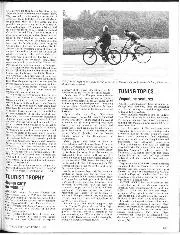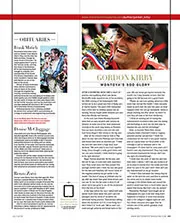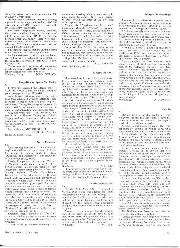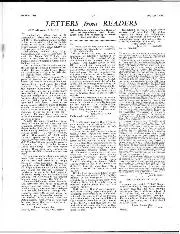N.B.—Opinions expressed, are those of our correspondents and Motor Sport does not necessarily associate itself with them—Ed.
THE SPORTS CAR HOUR
Sir,
With reference to the “sports car hour.” Are neither the 135.42 m.p.h. of a Type 57S Bugatti in 1930 nor the 105-odd m.p.h. of Nick Haines’ Healey a couple of years ago worth a mention?
And what has the Lyeett Bentley to do with Jaguar’s claim to be the fastest car in series production—not the fastest sports car ever made, which it patently is not, there being, to my knowledge, not even a universally agreed upon definition of the term “sports car” ? The Lyeett car is certainly not in series production, nor as far as can be gathered from the motoring journals in production trim.
I am, Yours, etc.,
Toronto. JOHN G. HENRY.
[We regret we also omitted to refer to Tony Crook’s 104.78 m.p.h. at Montlhery with only 2 litres of Bristol saloon, a very good show.—ED]
FAST ‘NASHES
Sir,
We have been informed officially by the British Racing Drivers’ Club, as organisers of the recent Silverstone meeting, that E. J. Newton in his Le Mans Replica Fraser-Nash lapped the Silverstone circuit (on two occasions) in 1 min. 58 sec. at an average speed of’ 88.13 m.p.h. This gives the Frazer-Nash the honour of making the fastest lap of the complete entry in both Division 1 and Division 2 of the Production Car Race and is a new sports-car record for the course.
In addition, T. A. D. Crook lapped the circuit (on two occasions). in 2 min., also F. R. Gerard, at an average speed of 86.60 m.p.h.
The lap speeds achieved by these three privately-owned and driven Fraser-Nashes are remarkable, not only affording proof of the production specification to which all Frazer-Nash models are built, but also in view of the fact that the Fraser-Nash is only of 2-litres capacity.
Only one other car of the complete entry—Stirling Moss driving a 3½-litre Jaguar—equalled the lap time of 2 min. made by T. A. D. Crook and F. R. Gerard.
In addition to holding the Silverstone circuit sports-car record, privately-owned and driven Frazer-Nash cars hold the sports-car lap record for the Castle Combe and Goodwood circuits.
I am, Yours, etc.,
Isleworth. W. H. ALDINGTON.
For A.F.N., Limited.
LAP RECORDS
Sir,
I was very interested in Mr. Steinway’s article on the Indianapolis 500 Mile Race in your May edition. I feel, however, that when the lap speeds were being compared with those at Brooklands mention might have been made of the late C. S. Staniland’s class lap record with the Multi-Union, as this car would be pernitted to run at Indianapolis (its engine is 2,946 c.c. supercharged).
The official Class D lap record to the credit of this driver and car stands at 141.45 m.p.h., but at the last Brooklands Race meeting, official timing credits them with a lap at 142.30 m.p.h. during a race.
This is some 4 m.p.h. faster than Straight’s Class C lap record with the Duesenberg and some 6 m.p.h. faster than Faulkner’s Indianapolis lap record, which was recorded in qualifying, when, I understand, only one car runs at a time. Furthermore, this “fastest lap” by Staniland was recorded when the Multi-Union was running on only seven of its eight cylinders.
In conclusion I should like to say how much I appreciate Motor Sport each. month.
I am, Yours, etc.,
Dundee. D. M. ALEXANDER.
MERCEDES BEATS ALFA
Sir,
” . . . and had the race not been abandoned Parnell would almost certainly have had the distinction of being the first driver, Ferrari the first car, to vanquish the all – conquering Alfa-Romeos.”
Permit me, by referring you to your June issue of 1939, to correct this highly erroneous statement. Turn to page 189 and you will find a report of probably the most shatteringly successful debut in the history of motor-racing. Here it is recorded that six 1,500-c.c. Alfa-Romeos, known as Alfettas, from which the present 1½-litre is the direct outcome of 13 years almost uninterrupted development, were, along with the usual assortment of Maseratis, completely routed by two little cars which now lie neglected and apparently forgotten in a country whose sole claim to fame is the invention of the cuckoo cloc ; two cars, which given similar development and without the aid of a thunderstorm, could repeat the seven minute victory over the only Alfa able to survive the scorching pace and heat on that Sunday afternoon in May, 1939.
I am, Yours, etc.,
JOSEPH BAYLEY.
[We were thinking expressly of the post-war 159 “all-conquering” Alfa-Romeos, but we are glad to add this tribute, to others in fairly recent. issues, of the 1½-litre Mercédès-Benz.—ED.]
WATT PRICE
Sir,
With reference to our letter dated May 30th, we very much regret that owing to a typographical error the new price of the Lagoada drophead coupè was quoted as being £2,235, plus Purchase Tax, £1,293 3s. 4d. This should have read £2,325, plus Purchase Tax, £1,293 3s. 4d. We shall be grateful if you will amend your records accordingly.
I am, Yours, etc.,
Staines. JAMES WATT
Director, Lagonda. Ltd.
RENIINISCENC ES
Sir,
I am much interested in the letters about Cardens of the early 1920s. In those days I was a salesman for a firm here in our market town and we got the agency for the £100 Carden somewhere about 1926, for the West Riding of Yorkshire. In those days we had a stand in the open market, and after the Olympia Show, 1925, we proudly drove our £100 model with display placards, etc., to our stand. But these cars had petroil lubrication, you mixed the oil with the petrol, and after a sudden stop were difficult to start again. I remember how we drove proudly up the street of crowded Yorkshire farmers until a policeman at the crossroads stopped us very suddenly to let a lorry through. “I’ll bet it won’t start again,” said my sales manager at the wheel. And it would not. We kicked and kicked at the kick-starter in vain. And to make matters worse the policeman, who knew us both, called out, “Put another penny in the slot, Richard.” The crowd laughed. We had to push the £100 car back to the garage and put up with much chaff. But we could not sell them, people would rather have an Austin Seven for a little more money and made by a firm they knew of. A doctor’s wife, whom I knew personally, nearly bought one. But one sad day out in the country the suspension had broken and let the engine and gearbox drop on the road in a village street. We were just picking it up when tne doctor and his wife came past in their Wolseley. It stopped the sale and I got chaffed for ever afterwards.
I am, Yours, etc.,
Knaresborough. G. A. SHAW.
Sir,
I too, was most interested to read of the New Carden’s participation in the Exeter, but think your correspondent rather less than fair to this remarkable little vehicle.
I vividly recall taking delivery of mine at Ascot in the siumner of 1921. It was my very first four-wheeler. The thrill of sitting at the wheel rather than handlebars and the almost paternal send-off by the Captain himself, were unforgettable experiences.
I did not, however, get far before coming to a spluttering stop. Frantically kicking again and again I decided that it was a case for “grey matter” rather than brawn. Yes, the magneto timing had slipped—a spanner, a hasty re-time and off once again.
Later the gearbox developed toothache, whereupon the second gear refused to “play ball,” the layshaft being out of alignment. The manufacturers were, however, very helpful, towing me from Leatherhead to the works. A short piece of angle iron in the appropriate place left me free of further serious trouble for about 3,000 miles of quite good if somewhat ” hard ” motoring.
Yes, the engine had a terrific “couple,” shaking the car’s rear-end like a terrier just emerged from a swim. This “shimmy ” was, however, almost cured by substituting semi-elliptic springs for the coils—at a very modest cost, too.
The alleged lubrication system was soon scrapped. I suspected dirty work during the night, for the natty little canister containing the oil was usually empty in the morning. The Carden shared quarters with an ancient Duo which sported, a splendid brass tank complete with plunger and drip feed. This, acquired for a shilling or two, was soon fitted, the lead being carried to the induction pipe, and it functioned well and subdued the over-oiling previously experienced.
So proud was I of the Carden that I repainted it. primrose (the original finish being awful) and with its black gleaming knife-board wings it really had quite a pleasing appearance.
Prices of the cheapest cars now put motoring beyond Mr. Everyman’s pocket and I am seriously considering building my own—850-c.c. engine, total weight about 400 lb., is the rough outline of my idea. After all, a cruising speed of 40 m.p.h. would satisfy most, and with is corresponding fuel economy I feel the attempt would be justified.
I am, Yours, etc.,
London, N.11. W. PARKER-GARRATT.
Sir,
A friend of mine owned a Duryea car in 1908 or 1909 and my recollection is that it was called the “Buggyaut.”
The chassis of this car was, I think, of ash. The engine shaft carried two grooved rollers at each end; these could slide laterally, the smaller roller providing low gear and the larger roller, high. There were smaller externally grooved rings on the back wheels, these provided reverse. Engagement was effected by moving the whole engine in the frame. An obvious disadvantage was that reverse was a higher gear than top.
I cannot remember if one cylinder had a valve in the piston crown but if it had this would obviously have been an inlet valve so there would have been no need for a deflector on the piston head.
I also travelled many miles in another Duryea car, which was made in Coventry by, I think, Henry Stanley. This had a three-cylinder horizontal engine amidships, with push-rod overhead valves, a three-speed epicyclic gear and single chain drive to a “traction engine” back axle.
I think this was in 1907. The steering was tiller with a central pillar and the throttle by twist grip. The car had a bonnet which contained nothing but the petrol tank and the performance was terrific for those days. In France we had great fun by leaving the bonnet open when we stopped, and the astonishment of the natives on seeing it empty was great.
I am, Yours, etc.,
JOHN CLIVE (Lt.-Col.)
Coln St. Aldwyn.
Sir,
I also have been interested in the “Tamplin and Carden” correspondence and would like to bring in the A.V. I enclose a photo of that which I owned in 1919, the lady obviously being arrayed as of that era. My most exciting moment was when starting her up by running her down a slight slope the top of the back cylinder blew off at the first explosion and disappeared into the hedge.
If it had been the front one, I should not be writing this letter.
I am, Yours, etc.,
London, W.1. E. J. VARDING.
Sir,
In correspondence in Motor Sport over the last year or so relating to cars of the 1920s, I have seen no mention of the Coventry Premier, and so I enclose a photograph, taken in the summer of 1922, of one owned by my father from that year until 1925.
In 1922 I was only 10 years old and had a limited knowledge of cars and, after nearly 30 years, my recollection of this vehicle is very hazy. I hope that you or some readers will be able to fill in the gaps. The car was made by the Singer Motor Co., and had a twin-cylinder engine of about 8 h.p. R.A.C. rating. It was fitted with a Cox Atmos carburetter and, I believe, an M.L. magneto. There was no self-starter or other electrical equipment other than three lamps. Suspension was by quarter-elliptics all round and the small-section tyres had their valves on the inside of the wheel discs—a bit tricky at the rear! There was a hood, but no side-screens. and, of course, no windscreen wiper. Two features, however,which the modern car lacks were included, compression taps on the cylinders into which petrol could be poured in cold weather (horrors!) and an exhaust valve lift control by Bowden cable which protruded beneath the radiator. This particular car’s registration number was PC 6761.
Following the Coventry Premier, my father had two 11.9-h.p. Lagondas, registration numbers XR 3386 and YR 5492. It would be interesting to know if any of your readers have any knowledge of the subsequent history of any of these cars.
I am, Yours, etc.,
London, S.W.15. KENNETH W. TOON.
Sir,
Once again, in your April issue, “Baladeur ” provides the high spot in his delightful article on the 1903 “Paris-Madrid.” For this and his many previous classic efforts we old-timers can hardly be too grateful to him. Curiously enough, on the very day before this issue came to me I was amusing my small daughter with her hummingg top; and at certain “revs.” this will prodnee an exact replica of the “chord of the old Gabriel” horn. I wonder if there are many of your present-day readers who can recall this most delightful of Edwardian accessories. A family friend had one (circa 1912) on lus “26 Met.” It was, I think, “tapped” direct into the exhaust pipe; just in front of the silencer, and fitted as a rule to lie alongside the outside of the running board valance. The instrument itself was made of brass, though equally often silver-plated, and was some 2½ feet long, and about 3-in. in diameter. I cannot speak, with any knowlolge, of the “works,” operation was by a beautiful little foot pedal inside the cockpit, similar toa “cut-out” pedal of that era. To hear it played gently on a still summer evening at some 25 m.p.h., was really beautiful. I call recall the “chord” as though it were yesterday.
I think, though doubtless “Baladeur ” will know, that this horn was named, after the redoubtable Mons. Gabriel; maybe even he was concerned with its manufacture. I have also heard it was named after the Archangel and his famous “trump”! Though expensive, some £10 I believe, these beautiful horns were worth every penny of that figure in terms of musical pleasure.
I am, Yours, etc.,
Arundel. L. H MUSKETT.




